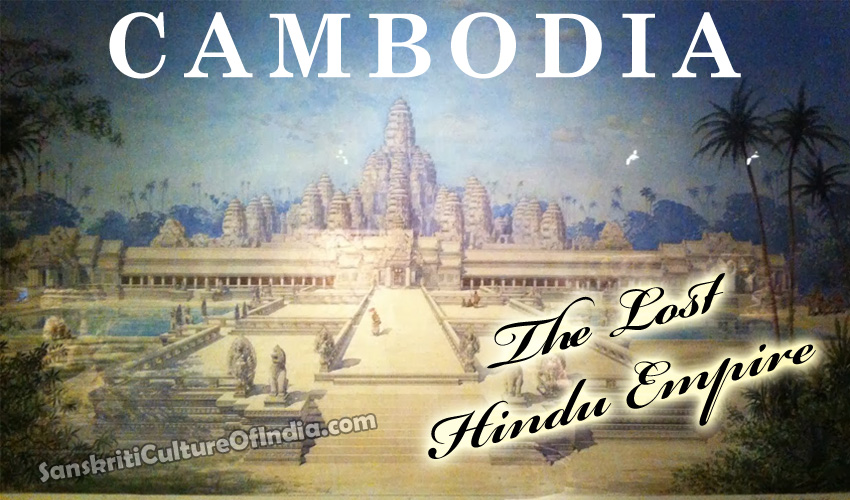A visit to Cambodia is recommended or may even be de rigueur for any Indian with an interest in the erstwhile history of India. For nowhere in the world outside India one can see the glory of its past splendor so well exhibited as in Cambodia. There are several hundred Hindu and Buddhist temple ruins throughout the countryside, especially around the town of Siem Reap near the large lake Tonle Sap. Siem Reap is the heart of the country. Here is where the splendid temple Angkor Wat has stood for nearly nine hundred years.
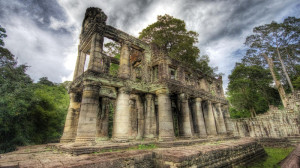 Mostly neglected for centuries and then ransacked and looted by occupying forces, the treasures of Cambodia are scattered all over the world now, mostly taken by Europeans. Smuggling of artifacts continues to this day. Cambodia has a very checkered history of war and destruction. It is only in the last one hundred years that attempts have been made to preserve, excavate and study the chronology of history, first by the French, and now by the rest of the world community. Indian and United States governments are also assisting in refurbishing and preserving the temples.
Mostly neglected for centuries and then ransacked and looted by occupying forces, the treasures of Cambodia are scattered all over the world now, mostly taken by Europeans. Smuggling of artifacts continues to this day. Cambodia has a very checkered history of war and destruction. It is only in the last one hundred years that attempts have been made to preserve, excavate and study the chronology of history, first by the French, and now by the rest of the world community. Indian and United States governments are also assisting in refurbishing and preserving the temples.
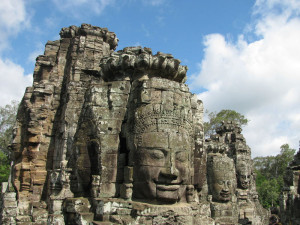 Many of the temple ruins appear like they are right out of pages of Rudyard Kipling’s books. Many with crumbling walls and roofs have seen better days. Giant trees hover over many temple walls, threatening their very foundations. Large roots of Kapok trees twine around the temples like giant mythical birds gripping them in their talons. Yet there is an indescribable charm that one immediately imbibes at first sight. Many ruins may look similar but one is drawn to see more. Those, which are preserved, demonstrate exquisite works of art and sculpture.
Many of the temple ruins appear like they are right out of pages of Rudyard Kipling’s books. Many with crumbling walls and roofs have seen better days. Giant trees hover over many temple walls, threatening their very foundations. Large roots of Kapok trees twine around the temples like giant mythical birds gripping them in their talons. Yet there is an indescribable charm that one immediately imbibes at first sight. Many ruins may look similar but one is drawn to see more. Those, which are preserved, demonstrate exquisite works of art and sculpture.
The people of this impoverished country are graceful and charming. They are simple, honest people, (mostly fishermen and farmers. There are not many towns outside a few larger cities. Once you leave the city limits of Phnom Penh there are not many homes or buildings of significant magnitude. Two-wheelers are the main modes of transportation, often attached to trailers that are used to transport families and goods. The vendors selling books, shawls and skirts are mostly beautiful children at temple sites, who surprise the tourists with better English than one would expect them to speak. These children are not scrappy, but not pushovers either and they can drive a hard bargain.
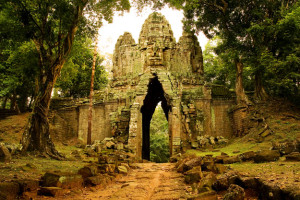 The scattered temples are mostly deserted reminders of the former glory of the Khmer people, the dominant people of the region. Their kingdoms waxed and waned, to include parts of Thailand (Siam), Vietnam (Champa) and Laos at various times. There have been wars and skirmishes between the Khmer people and their neighbors for centuries. The most recent involvement of Cambodia in the larger war in Vietnam, when the country was carpet bombed by the might of the American military, was just one of several wars in its history to cause much death and destruction. Following the American exit, civil war had kept the country impoverished and desperate until the year 2000 when it gained independence and now has a nascent socialist democracy.
The scattered temples are mostly deserted reminders of the former glory of the Khmer people, the dominant people of the region. Their kingdoms waxed and waned, to include parts of Thailand (Siam), Vietnam (Champa) and Laos at various times. There have been wars and skirmishes between the Khmer people and their neighbors for centuries. The most recent involvement of Cambodia in the larger war in Vietnam, when the country was carpet bombed by the might of the American military, was just one of several wars in its history to cause much death and destruction. Following the American exit, civil war had kept the country impoverished and desperate until the year 2000 when it gained independence and now has a nascent socialist democracy.
The early history of Cambodia is best studied as Pre- Angkor era and Angkor era. Angkor is a ‘Khmer-ization’ of the Sanskrit word Nagara, meaning city.
Pre-Angkor History
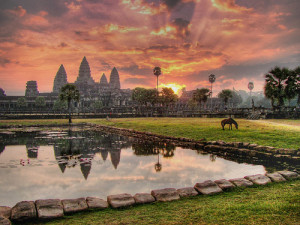 Pre-history of Cambodia starts with the legendary Khambujaraja, a Brahmanical king of India, who had come to the region and faced adversity from a beautiful lady on the mountain. After a brief fight between them, a truce was drawn and the beautiful lady, Mero by name, married Khambuja. The country they jointly ruled was called Khambujadesa and their descendants were called the Khmer people. Khambujadesa later became Kampuchea and then Cambodia. The original language spoken was Mon-Khmer. Later in the 6th century the ‘Mon’ people moved further west to Thailand and the Khmer remained in current day Cambodia.
Pre-history of Cambodia starts with the legendary Khambujaraja, a Brahmanical king of India, who had come to the region and faced adversity from a beautiful lady on the mountain. After a brief fight between them, a truce was drawn and the beautiful lady, Mero by name, married Khambuja. The country they jointly ruled was called Khambujadesa and their descendants were called the Khmer people. Khambujadesa later became Kampuchea and then Cambodia. The original language spoken was Mon-Khmer. Later in the 6th century the ‘Mon’ people moved further west to Thailand and the Khmer remained in current day Cambodia.
Indian influence in the region began in the first century C. E. They traded goods with Khmer by way of sea, when spice and silk trade had flourished. Both Indians and Chinese exerted their influences on the local people but Indian culture took a firm foothold, perhaps through the efforts of Brahmin priests. The rulers of the time had a suffix of ‘Varman’ to their names, similar to the Pallava kings of Kanchipuram. Whilst the Cholas of Tanjavur in India eventually defeated the Pallava Varmans in the 8th century, the Khmer kingdoms flourished well into the 14th century. Though all the rulers of Cambodia bore the name ‘Varman,’ they did not necessarily belong to the same dynasty. At various periods in their history, the rulers and usurpers came from Siam (Thailand) or Champa (Vietnam) as well as Khambujadesa (Cambodia or Kampuchea).
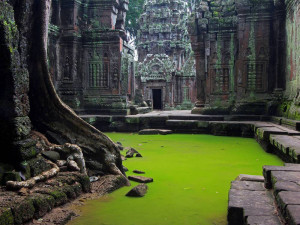 There are historical references suggesting that Cambodia had been inhabited in the 3rd millennium B.C.E. Chinese travelers later chronicled the first established kingdom. The first kingdom was called Funan (an alteration of the word bnam or mountain in Khmer language). A certain Kaundinya, inspired by a dream, traveled from India and married a local princess Soma, belonging to the naga (cobra) tribe. He established the first Kaundinya dynasty of Funan. Later in the 5th century a second traveler from India – Kaundinya Jayavarman (478-514) arrived and focused on re-establishing the Indian culture. He established a more defined Funan kingdom and was later followed by Rudravarman in the sixth century. He was responsible for the first sculptures, mostly of Vishnu.
There are historical references suggesting that Cambodia had been inhabited in the 3rd millennium B.C.E. Chinese travelers later chronicled the first established kingdom. The first kingdom was called Funan (an alteration of the word bnam or mountain in Khmer language). A certain Kaundinya, inspired by a dream, traveled from India and married a local princess Soma, belonging to the naga (cobra) tribe. He established the first Kaundinya dynasty of Funan. Later in the 5th century a second traveler from India – Kaundinya Jayavarman (478-514) arrived and focused on re-establishing the Indian culture. He established a more defined Funan kingdom and was later followed by Rudravarman in the sixth century. He was responsible for the first sculptures, mostly of Vishnu.
After the decline of Funan kingdom Khmer people established Chenla kingdom, where the names of kings Shrutavarman and Sheshthavarman are mentioned. They established their capital in Shreshthapura. Later Ishanavarman, from the Khmer kingdom of Bhavapura, defeated the remnants of Funan, and established his capital in Ishanapura.
Jayavarman I followed him and then his successor Pushkaraksha again united the splintered principalities in the year 716. His capital was Shambhupura (currently Sambor). His heirs maintained control over the kingdom until the end of 8th century, when Malayans and Javanese (Jayavarman II) gained dominion over many Khmer principalities. During this pre-Angkor period many temples were built, though they did not demonstrate the same style of architecture or the confidence of the later builders.
The Golden Period
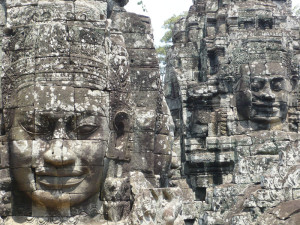 The glory of Cambodia and its temples began in earnest during the rule of Jayavarman II beginning 802 C. E. It is thought that he came from the royal court in ‘Java’ to conquer smaller Khmer states. He declared a unified and sovereign Khambujadesa, independent of Javanese influence. This was when the Angkor era in the history of Cambodia was born. He named his capital city Hariharalaya and introduced ‘linga-cult.’ to his kingdom. The cult of Devaraja or the God King (the terrestrial counterpart of the celestial being) was also introduced by Jayavarman II. The capital stayed around the large Lake Tonle Sap, in and around the city of Siem Reap (until the 15th century, well after the demise of Hindu empires, when it was moved to Phnom Penh).
The glory of Cambodia and its temples began in earnest during the rule of Jayavarman II beginning 802 C. E. It is thought that he came from the royal court in ‘Java’ to conquer smaller Khmer states. He declared a unified and sovereign Khambujadesa, independent of Javanese influence. This was when the Angkor era in the history of Cambodia was born. He named his capital city Hariharalaya and introduced ‘linga-cult.’ to his kingdom. The cult of Devaraja or the God King (the terrestrial counterpart of the celestial being) was also introduced by Jayavarman II. The capital stayed around the large Lake Tonle Sap, in and around the city of Siem Reap (until the 15th century, well after the demise of Hindu empires, when it was moved to Phnom Penh).
Thirty years after Jayavarman II’s death, his successor Indravarman I constructed the first major temple in his honor (one of the so called Rolous group of temples). From then on the rulers busied themselves in building temples using bricks, sandstone and laterite. Often they were painted in bright colors. They also built large water reservoirs called barays. Following Indravarman I, his son Yasovarman I built many more temples and barays.
Rajendravarman in the 10th century was a ruler busy building another half a dozen temples, the best preserved and an architectural masterpiece at Bantay Srei.
During the rule of Udayadityavarman II, several lingas were carved in the riverbed on Phnom Kulen (called Mahendraparvata at the time). Today it is known as the ‘River of thousand lingas’ and is a tourist attraction in its own right. It was believed that the water that flowed over the countless lingas of the river would fertilize the rice fields below. A short hike up the mountain will take a visitor to the place of thousand lingas at Kbal Spean.
The first inscriptions found on temple walls, dating back to 5th century, resembled the script used by Pallavas of South India. Later, the Khmer developed their own unique script and carved them into the walls mostly describing the temple and its deity but sometimes the inscriptions were just mundane details like a list of inventory. There are as many inscriptions in Sanskrit language as in Khmer language.
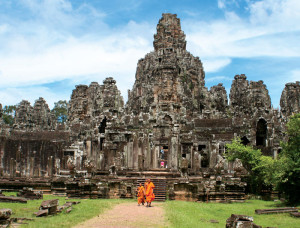 The first decade of 11th century witnessed the ascent to the throne of a powerful king Suryavarman I (1010-1050), who unified almost all of Khambuja and southern Thailand. He was also a busy builder of temples and royal palaces. Following his rule, Suryavarman II (1113-1150) further expanded the kingdom. He also built the glorious temple Angkor Wat (from the Indian words Nagara Vata – City Temple), the pinnacle of temples built in Cambodia.
The first decade of 11th century witnessed the ascent to the throne of a powerful king Suryavarman I (1010-1050), who unified almost all of Khambuja and southern Thailand. He was also a busy builder of temples and royal palaces. Following his rule, Suryavarman II (1113-1150) further expanded the kingdom. He also built the glorious temple Angkor Wat (from the Indian words Nagara Vata – City Temple), the pinnacle of temples built in Cambodia.
The sprawling temple spreads over a one square mile area. Long walls with stories of Hindu mythology are sculpted as bas-reliefs. It is a magnificent temple complex, constructed in the form of mythological Mount Meru – the Hindu center of the Universe. The temple is surrounded by a large moat, representing the ocean surrounding Mt. Meru. The brilliant paint used to enhance the reliefs has faded but the architecture and beauty are still preserved. The sheer magnitude of the temple complex is impressive.
All the gods of the Hindu pantheon are represented in temple sculpture. Shiva and Vishnu were held in high esteem. Ramayana and Kurukshetra war are depicted on entire walls of stone sculptures. A masterpiece bas-relief is that of the legendary churning of the ocean by the gods and demons.
Sculptures of Vishnu on the back of his vessel Garuda or reclining on the serpent Ananta and Shiva with his consort Parvati are repeated in many temples. Also seen are Hanuman and Ganesh, along with many seductive figures of Apsaras – reminiscent of Dev-dasis, the consorts of the Gods.
Another colorful king Jayavarman VII (1181-1220) followed Suryavaramn II. The kingdom had briefly fallen into the hands of the Chams of Champa, but the warrior-like Jayavarman VII reclaimed it and united Khambuja once again. He expanded his kingdom to include southern Malaya and northern Laos as well as Champa. Burmese kingdoms including Java became subsidiaries.
Jayavarman VII was married to a Buddhist woman and later became a Buddhist himself. Builder of dozen or more significant temples and palaces including the great Angkor Thom, he built many Buddhist monasteries and converted many Hindu temples into Buddhist shrines. The elephant terrace and the statue of the Leper King are in Angkor Thom. The statue when first found with blunted fingers, was first thought to be of a leper (the French mistook the weather damaged fingers to be that of a leper), but in fact is that of Yama, the king of death. The Elephant Terrace is a ceremonial altar in facing the Royal Square, supported by beautifully carved figures of elephants and mythical creatures. At the entrance to Angkor Thom is a large tower, large enough to admit elephants. On either side of the road near the entrance are rows of large statues, with angelic face on one side and the scornful evil face on the other.
Jayavarman VII declared himself to be Bodhisattva (as opposed to Devaraja – God-king – introduced by Jayavarman II). His delusions of grandeur are evident in the sculptures of colossal facial images of himself on temples, especially at the towers of Bayon. Thus Mahayana Buddhism (higher vehicle) had been introduced to Khambuja, which in turn marked the beginning of the end of a glorious Hindu era.
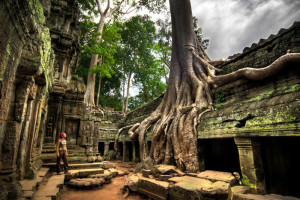 Following Jayavarman VII’s death, skirmishes arose again both within the kingdom and in its bordering regions. Brahmins tried to reassert their authority with the help of Jayavarman VIII and tried to usurp Buddhist power. However, their influence did not last too long. Soon after his death Buddhism returned once again, though it was the Hinayana Buddhism ((Theravada or lesser vehicle) that took final foothold and still remains the dominant religion of Cambodia today. The advent of Buddhism effectively put a stop to the building spree in Cambodia. Some of the existing Hindu temples were converted to Buddhist temples and monasteries. Gods of Hindu pantheon were removed and replaced with statues of Buddha.
Following Jayavarman VII’s death, skirmishes arose again both within the kingdom and in its bordering regions. Brahmins tried to reassert their authority with the help of Jayavarman VIII and tried to usurp Buddhist power. However, their influence did not last too long. Soon after his death Buddhism returned once again, though it was the Hinayana Buddhism ((Theravada or lesser vehicle) that took final foothold and still remains the dominant religion of Cambodia today. The advent of Buddhism effectively put a stop to the building spree in Cambodia. Some of the existing Hindu temples were converted to Buddhist temples and monasteries. Gods of Hindu pantheon were removed and replaced with statues of Buddha.
Statues of Buddha had already appeared in the pre-Angkor period. These were mostly ushnisha Buddha (with the knot in the head, denoting enlightenment and Nirvana) in the standing position. Later Buddha statues appeared in many other positions of the hands of giving, preaching and blessing. Bodhisattvas and Avalokiteshvara – Lord of the World (Lokeshvara in Khmer) also are seen.
The last king of record from the lost empire is Jayavarman Parameshvara (1327 – ?). In the meantime, the first large Thai state, Sukhothai, had occupied much of the northern and western territories of Khmer empire. In 1430 a Thai king, Paramaraja II of Ayuthya laid siege on the capital and conquered it in seven months. From then on the decline, abandon and decadence set in. Discussion of the upheaval and the tumult in the ensuing history of the kingdom in the following centuries is beyond the scope of this article.
During medieval times the capital was moved to Phnom Penh. Today it is a city with orderly traffic with clean air and streets, with none of the typical hustle and bustle of a mega-city in South East Asia. There are many Pagodas and Buddhist monuments with larger than life sized statutes of Buddha (including the Emerald Buddha), adorned with gold and decorated with diamonds. The use of jewels on the statue of Buddha, who had taken a vow of poverty, is curious. This is explained by the desire to emphasize the pre-eminence of the Enlightened one, who is the chakravartin – a sovereign of the Universe – worthy of jewels and riches.
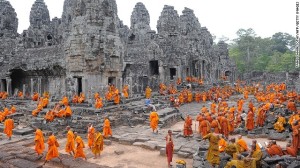 There is an interesting story about Phnom Penh. The word Phnom means mountain. Penh is a Khmer word, meaning woman. This is where a beautiful woman sitting on the mountaintop had confronted the wandering king from India, and eventually became his consort. The place came to be known as Phnom Penh – mountain woman. Interestingly the word Penh (or Pen – reflexive n) means a woman in the Tamil language as well.
There is an interesting story about Phnom Penh. The word Phnom means mountain. Penh is a Khmer word, meaning woman. This is where a beautiful woman sitting on the mountaintop had confronted the wandering king from India, and eventually became his consort. The place came to be known as Phnom Penh – mountain woman. Interestingly the word Penh (or Pen – reflexive n) means a woman in the Tamil language as well.
The epic story of Ramayana plays an important part in the philosophical and cultural life in Cambodia. The Khmer version, referred to as Reamker, is carved into the walls of Angkor Wat. Reamker follows the characters depicted in the Indian Ramayana with some of its own twists. It is a philosophical allegory that combines Hinduism with Buddhism. Though written in the 16th or 17th century, a full half a millennium after the sculptures of Angkor Wat, it formed the basis of Khmer life and philosophy from the time of its origing. It is the foundation of the Royal Ballet repertoire and classical theater and dance.
The protagonist of the story is Preah Ream whose wife is called Neang Seda. His brother is Preah Leak and his antagonist Ravana is called Krong Reap. Hanuman even has a love interest in a mermaid princess called Sovanna Maccha (translates to Golden Fish). Interestingly the Thai version of Ramayana (called Ramakien) is actually an adaptation of Reamker rather than the Indian original.
Conclusion
More than a million people lived around the region of Angkor Wat (Siem Reap) during its peak. Today, the Hindu population of Cambodia (population approximately 14 million) is not even measurable. The majority belongs to the Buddhist religion. Though mainly based on Hinayana (lesser Vehicle), a unique potpourri of Buddhism that is currently practiced. Its pantheon of gods includes many Hindu idols. They have not forgotten their history and still pay their obeisance to god Vishnu and Shiva as well as worship Buddha.
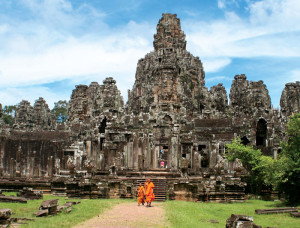 The lost Hindu empire of Cambodia is marked by hundreds of temples. It is the product of sweat and blood of devoted subjects of many rulers with a passion for building. Many of the temples have crumbled from neglect and vandalized. Many have not withstood the onslaught of centuries of harsh weather.
The lost Hindu empire of Cambodia is marked by hundreds of temples. It is the product of sweat and blood of devoted subjects of many rulers with a passion for building. Many of the temples have crumbled from neglect and vandalized. Many have not withstood the onslaught of centuries of harsh weather.
But the memory of the glory of the empires left behind by its temple-building rulers is lasting. Its vibrant former civilization and culture are firmly etched in stone sculptures, and in their ancient scripts. The beautiful bas-reliefs depicting Hindu Purana are delicate as well as delightful. The sculpted figures of lovely apsaras on its temple walls, with their modern appearing hairdo and dresses are esthetically pleasing to the eyes. The neglected temples of Ta Prohm and Preah Khan, with their overgrown roots of Kapok trees are sights to behold. The rooftops appear to be strangled by giant talons of some mythical birds in a vise-like grip. Tree roots snake around the temple walls like Anacondas lazily bathing in the sun.
Palace city of Angkor Thom with its Elephant Terrace and the Leper King (which actually is a sculpture of Yama with blunted fingers – due to damage – and so it came to be known as the Leper King), and the rows of giant statues at the entrance with the large gate are majestic. Angkor Wat is awe-inspiring by its sheer magnitude and architectural finesse.
To see all the ruins will take many trips to Cambodia but a student of history and anyone with curiosity about the eastward spread of the Indian Diaspora in yesteryears must pay at least a visit to Cambodia.
~ Dr. Neria H. Hebbar

